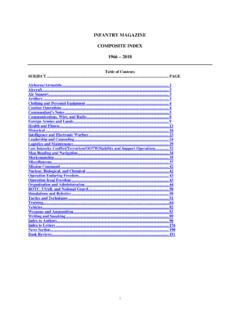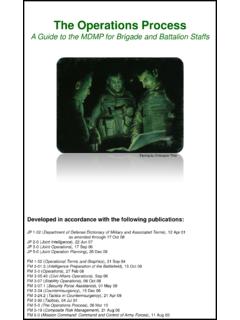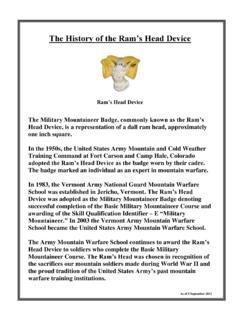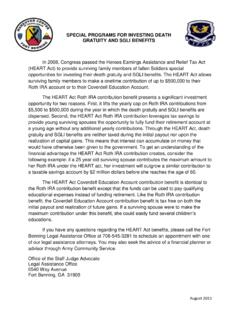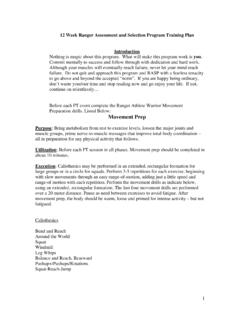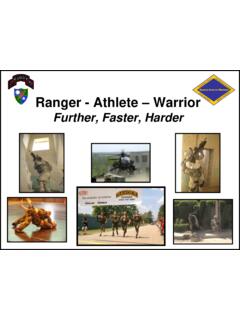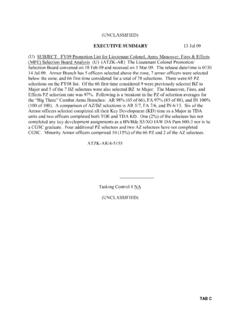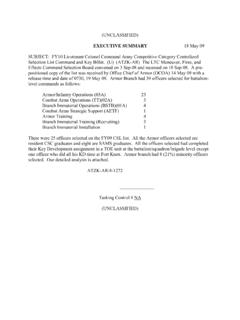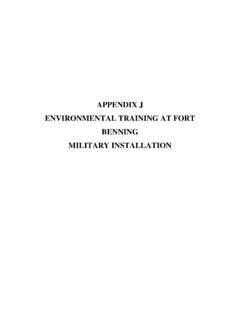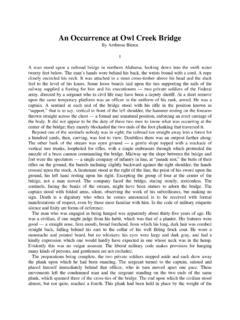Transcription of Initial Commander’s Critical Information Requirements …
1 Initial commander s Critical Information Requirements and the 5 Common Command Decisions by COL Thomas M. Feltey and CPT Matt Mattingly commander s Critical Information Requirements (CCIR) assist the commander in making timely and effective decisions. CCIR identifies reconnaissance objectives and drives the commander s reconnaissance guidance. Clear commander s guidance empowers the scout to think like the commander , take disciplined initiative and develop the situation as the commander would if he were in each observation post or on every patrol. This exercise in mission command flattens the battlefield and allows the organization to maintain tempo while meeting mission Requirements . Logically, to develop CCIR, the staff must identify what decisions the commander will need to make during the course of the operation. Decision points are developed during course-of-action (CoA) analysis, Step 4 of the military decision-making process (MDMP).
2 1 The difficulty many staffs encounter is that MDMP requires development of Initial CCIR as an output of mission analysis2 Step 2 of MDMP and publishing in Warning Order The advantages of publishing CCIR early are multiple. At a minimum, it enables parallel planning, especially for cavalry organizations and scout platoons. It also gives the commander an option to execute a reconnaissance pull. The reconnaissance pull allows commanders to employ forces rapidly to seize opportunity or when time is limited, and use scouts to pull forces into positions of So how does a unit develop CCIR, based on command decisions, during mission analysis when the decisions won t be identified until CoA analysis? Commanders can and should provide guidance on CCIR based on their visualization of the operation, CoA guidance and the anticipated decisions to be Staff can also assist the commander by working from a list of common decisions and subsequent CCIR that can be refined during the planning process.
3 The origin of this technique has been lost to history; however, it was a common practice in 3rd Armored Cavalry Regiment (ACR), 11th ACR and at the National Training Center in the era preceding the global war on terrorism. As the Army s premier lethality training brigade, 316th Cavalry Brigade has refined the technique and developed a list of five common battlefield command decisions to assist units with rapid CCIR development and timely deployment of cavalry organizations. Change of task organization Task organization and reorganization provides commanders with flexibility to adapt to changing circumstances and react effectively to the enemy to achieve mission Priority Information Requirements (PIR) for this decision include enemy formations at unanticipated locations or strength. Friendly-forces Information Requirements (FFIR) for this decision include loss of an asset Critical to mission accomplishment.
4 Example: A light infantry battalion is tasked to conduct a movement-to-contact against a well-organized, militia-style enemy. Enemy CoA 1 has them operating in a loose area defense. Enemy CoA 2 has them operating in a concentrated strong-point defense. The battalion task-organizes the weapons-company platoons evenly across three infantry companies. However, the commander recognizes that identification of enemy CoA 2 will require another weapons platoon to be task-organized to the company in contact. Recognizing this early in the MDMP process provides the scout platoon with PIR that may trigger the reorganization prior to the companies making contact and assists the weapons-company commander with the troop-leading procedures (TLP) process. Table 1 shows the if-then decisions. PIR (if) FFIR (and) Decision (then) Enemy conducts strong-point defense Weapons company > 75% strength Shift weapons platoon to adjacent company Table 1.
5 Change of unit boundary Changing a unit boundary typically corresponds with reassigning tasks to be accomplished within that boundary from one subordinate force to another. This is necessary when the terrain or enemy situation significantly differs from the templated situation and the survival of a force or tempo of an operation is threatened. Changing unit boundaries requires subordinate leadership to maintain higher-echelon graphics and understand adjacent unit tasks and purposes. FFIR include loss of combat power or failure to accomplish required tasks on time in accordance with the execution matrix. PIR may include adverse terrain conditions, location of enemy forces or enemy task organization. Example: A Stryker brigade combat team (SBCT) cavalry squadron is conducting a zone reconnaissance to enable the brigade s approach march through the enemy disruption zone.
6 Rapid deployment of the brigade into the combat zone is Critical , and the squadron must accomplish its reconnaissance objectives on a strict timeline. The squadron commander identifies this requirement up front and develops control measures and associated FFIR to ensure the unit maintains tempo. Early identification of this requirement allows these measures to be included in the wargame and rehearsals. Subordinate maneuver units anticipate that they may take on adjacent unit tasks and can plan and rehears accordingly. Table 2 shows the if-then decisions. PIR (if) FFIR (and) Decision (then) Enemy not defending west of Phase Line (PL) Dog Troop fails to reach PL Dog Reassign named areas of interest Table 2. Commit reserve Commanders commit the reserve to retain initiative, exploit success or counter actions that threaten the integrity of friendly It is inherent in the designation of the reserve that the conditions for its employment be identified and reporting Requirements enumerated in the CCIR.
7 FFIR may include loss of combat power or Critical systems. PIR may include location of enemy formations, enemy task organization and attrition of enemy forces or high-priority targets. Example: An armored BCT (ABCT) conducts a defensive cover to provide the corps with enough time to generate combat power at a port. The brigade S-2 predicts the enemy will concentrate its limited number of T-90 tanks with the main effort. The brigade commander expects to commit his reserve against the enemy s main effort. Developing PIR to identify T-90s will orient the cavalry squadron on a specific reconnaissance objective, help scouts develop accurate indicators and assist the combined-arms battalions (CABs) with recommendations to brigade. Table 3 shows the if-then decisions. PIR (if) FFIR (and) Decision (then) 1 company of T-90s CAB loses 3 platoons of combat power Commit the reserve Table 3.
8 Transition phases Phases divide an operation to focus effort, concentrate combat power at decisive points and accomplish objectives deliberately and Decisive action requires a high degree of synchronization. FFIR designed to support understanding the location and composition of friendly forces is Critical to the decision to transition. PIR may relate to the suitability of forward routes or enemy composition. Example: A CAB is conducting a deliberate breach. Before fully developing a CoA, the commander can foresee that the composition of the obstacle must be confirmed, as well as the location of overwatch positions. This anticipation allows the scout platoon to begin TLPs, or possibly even initiate a stealthy reconnaissance, to begin collecting on enemy and obstacles. Table 4 shows the if-then decisions. PIR (if) FFIR (and) Decision (then) Composition of enemy obstacle belt confirmed Support by fire set Initiate Phase III (breach) Table 4.
9 Execute a branch plan or sequel A branch is a contingency operation initiated as a result of adversary action, availability of friendly capabilities or resources, or even a change in the weather or season within the area of operations. 9 A sequel is the subsequent major operation or phase based on the possible outcomes (success, stalemate or defeat) of the current major operation or phase. 10 Commanders require a solid understanding of battlefield conditions when changing to a branch or transitioning to a sequel. PIR related to enemy composition, task-organization, actions and reactions help the commander anticipate success, stalemate or defeat of the friendly operation. Concurrent to main body offensive or defensive operations, scouts may conduct reconnaissance of adjacent areas focused on enemy or terrain to facilitate reorientation of forces to branch axes of approach.
10 FFIR related to availability of maneuver, fires or sustainment will enhance informed decision-making. Example: An SBCT is conducting an envelopment, with the cavalry squadron out front in a zone reconnaissance. Upon completion of the mission-analysis brief, the commander identifies that the squadron must identify and avoid principle enemy defenses and locate an assailable flank. This Information will help the brigade determine which enemy CoA to plan against. Early understanding of the reconnaissance objectives allows the squadron maximum time to plan and initiate reconnaissance ahead of the brigade, allowing greater use of stealth and more detailed collection. Troop B encounters heavy resistance that meets indicators of the enemy main effort and seems to confirm enemy CoA 1. Troop A identifies a weak point in the enemy lines, also in line with enemy CoA 1, and conducts a forward-passage-of-lines (FPOL) with a sister infantry battalion.
